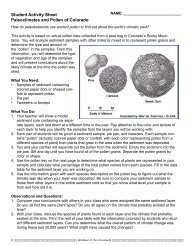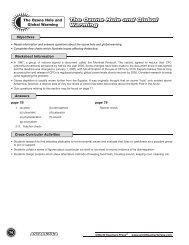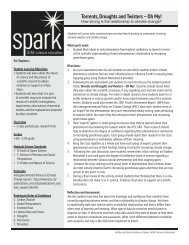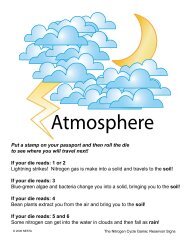Earth's Global Electric Circuit - Spark - University Corporation for ...
Earth's Global Electric Circuit - Spark - University Corporation for ...
Earth's Global Electric Circuit - Spark - University Corporation for ...
You also want an ePaper? Increase the reach of your titles
YUMPU automatically turns print PDFs into web optimized ePapers that Google loves.
<strong>Global</strong><br />
<strong>Electric</strong><br />
<strong>Circuit</strong><br />
Terms<br />
Ionospheric D, E, and F Regions: Horizontal strata in the middle and upper atmosphere<br />
of the Earth where free electrons are sufficiently abundant to affect the<br />
passage of radio and other electromagnetic radiation through these regions: D<br />
region @40-60 miles; E region 60-80, and F region about 100 to 1000 miles or<br />
more above Earth’s surface<br />
Jet: electrical phenomena associated with upward-directed lightning shooting<br />
out of cloud tops with various sizes. Jets are most commonly blue in color.<br />
Solar Cycle: The approximately 11-year quasi-periodic variation in frequency<br />
or number of solar active events.<br />
Solar Maximum: The month(s) during the solar cycle when the 12-month<br />
meanof monthly average sunspot number reaches a maximum.<br />
Solar Minimum: The month(s) during the solar cycle when the 12-month<br />
mean of monthly average sunsport numbers reaches a minimum.<br />
<strong>Global</strong><br />
<strong>Electric</strong><br />
<strong>Circuit</strong><br />
Terms<br />
Magnetic Field: a mathematical description of the magnetic influence of electric<br />
currents and magnetic materials. At any given point, it is specified by both<br />
a direction and a magnitude (or strength) and is produced by moving electric<br />
charges and the intrinsic magnetic moments of elementary particles.<br />
Magnetosphere: The magnetic cavity surrounding the earth, carved out of the<br />
passing SOLAR WIND by virtue of the Earth’s geomagnetic field which<br />
prevents, or at least impedes, the direct entry of the solar wind plasma<br />
into the cavity.<br />
Mesosphere: a layer of Earth’s atmosphere above the stratosphere approximately<br />
50 km (31 miles) to 85 km (53 miles) high<br />
Model (scientific/mathematical): a mathematical description of nature and its<br />
processes that can be tested and can predict things about many similar<br />
situations<br />
Neutron: A subatomic particle <strong>for</strong>ming part of the nucleus of an atom and<br />
having no charge<br />
Ohm’s Law: Ohm’s law states that the current through a conductor between two<br />
points is directly proportional to the potential difference across the two points.<br />
Plasma: Any ionized gas, that is, any gas containing ions and electrons<br />
Potential Gradient (V/m): also called electrical potential that refers to the<br />
electric potential chage measured between two points<br />
Proton: A subatomic particle <strong>for</strong>ming part of the nucleus of an atom and<br />
having a positive charge<br />
Radiation: a process in which energetic particles or energetic waves travel<br />
through a media or vacuum that are not required <strong>for</strong> their propagation.<br />
Radiation Belts; “belts” <strong>for</strong>med by clouds and currents of particles that are<br />
trapped in Earth’s magnetic field high in the atmosphere<br />
Resistance: a measure of the degree to which an object opposes an electric<br />
current through it<br />
Solar Wind: The outward flux of solar particles and magnetic fields from the<br />
Sun. Typically, solar wind velocities are near 350 km/s.<br />
Sprite: large, brief, and often highly-structured bursts of light occurring high<br />
above thunderstorms in response to cloud-to-ground lightning flashes that<br />
remove large amounts of charge from the upper portions of a cloud. A single<br />
sprite can span altitudes from 40 km up to 80 km (25 miles to 50 miles)<br />
Stratosphere: the second major layer of Earth’s atmosphere, just above the<br />
troposphere, and below the mesosphere. It is stratified in temperature, with<br />
warmer layers higher up and cooler layers farther down and occurs from approximately<br />
10–13 km (30,000–40,000 ft; 6–8 mi) and 50 km (160,000 ft; 31<br />
mi) altitude above the surface.<br />
Thermosphere: the layer of Earth’s atmosphere directly above the mesosphere<br />
where the Sun’s ultraviolet radiation (UV) causes ionization or charged<br />
particles in a region called the ionosphere. Meaning heat in Greek, the<br />
thermosphere begins about 85 kilometres (53 mi) above the Earth and<br />
temperatures increase with altitude due to absorption of highly energetic<br />
solar radiation. Temperatures are highly dependent on solar activity, and can<br />
rise to 2,000 °C (3,630 °F).<br />
Transient Luminous Events (TLEs): a term that collectively includes fleeting<br />
optical and electrical phenomena associated with lightning and electrified<br />
clouds in Earth’s atmosphere that include elves, sprites, and jets<br />
TRMM Satellite: NASA’s Tropical Rainfall Measuring Mission designed to study<br />
tropical rainfall<br />
Troposphere: the lowest layer of Earth’s atmosphere extending to appoxi 20<br />
km (or 12 miles) at most at the equator where it is thickest. Weather occurs in<br />
this layer and temperatures commonly decrease in altitute.<br />
Voltage: electric potential energy per unit charge, measured in joules per<br />
coulomb ( = volts)<br />
Wilson Current: semicontinuous current flow above electrified clouds considered<br />
a critical component of the global electric circuit; however, only a few<br />
studies have directly investigated this current, yielding a few dozen<br />
measurements.<br />
Schumann Resonance: global electromagnetic resonances, excited by lightning<br />
26. 27.















